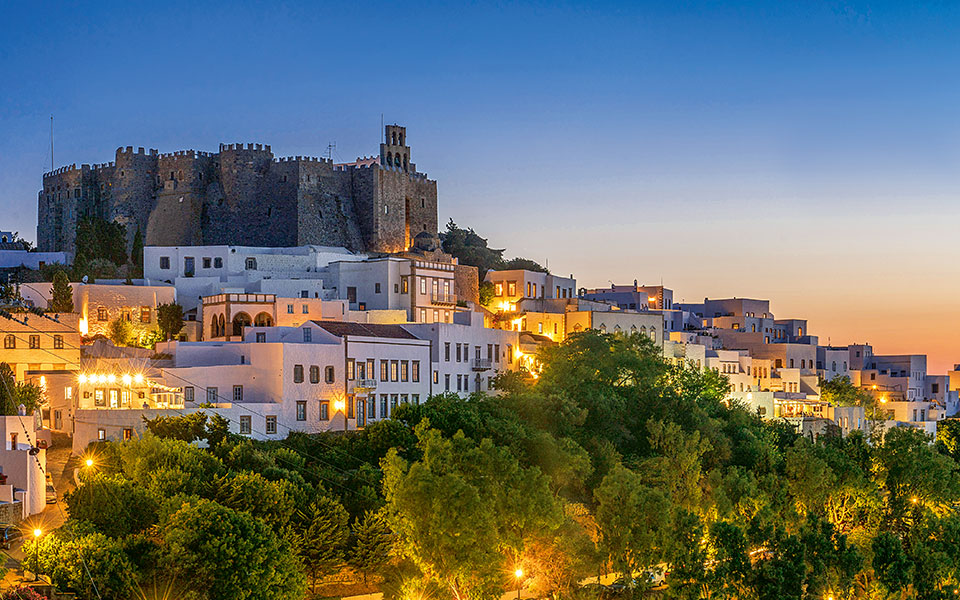EXPLORE
WORLD HERITAGE: Shortly before sunset is the best time to wander through the narrow streets of Hora which, along with the Monastery of Saint John and the Cave of the Apocalypse, have been designated as UNESCO World Heritage Sites. Built just below and around the fortified monastery, Hora, too, resembles a fortress. Stroll through its maze of alleyways awash in tumbling bougainvillea, admire the dazzling whitewashed houses and mansions, many of which date from the 16th century, and take note of their flat rooftops. They were built this way so as to create an “overhead” transport and communication network, so that vulnerable parts of town could be quickly reinforced. The square houses with thick stone walls were built close together, especially along the outer perimeter, to form a defensive wall against pirates. In addition, their exteriors were more or less identical; the homes of the rich and the poor were indistinguishable, which meant the former could not be easily targeted. Conclude your walk at the entrance to the monastery, from where you can see the snow-white port town of Skala below in the distance.
Info
- Area: 34 sq. km.
- Population: 3,045 (2011 census)
- Distance: 163 (sea miles from Piraeus)
- Highest Peak: 269m (Profitis Ilias)
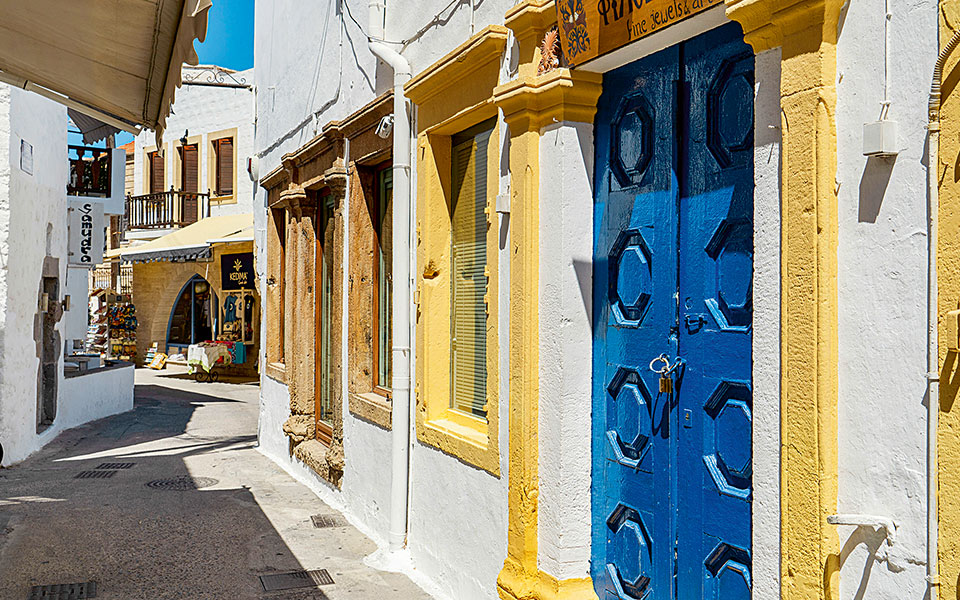
© Perikles Merakos

© Perikles Merakos
MUST-READ: Keep an eye out for Footpaths of Patmos, published by Anavasi. Its author, Despoina Vakratsi, presents the best hiking trails on the island, along with a wealth of information about the folklore, culture, history and natural environment of the island.
EXPERIENCE
BEST SWIMS: One of the island’s most beautiful beaches is Lambi, in the north of Patmos. It’s famous for its rare, multi-colored pebbles (please refrain from taking any as souvenirs; their number has dwindled alarmingly). Not far from here, you’ll also find the remote Livadi ton Kalogiron, a beach with large pebbles. Agriolivado, about 3km north of Skala on the road to Kambos, is one of only very few beaches on the island with sun loungers and umbrellas. It has crystal-clear, bracingly cool waters, sand and an impressive row of trees. On the south coast, a particularly attractive bay with refreshingly cool waters is Grikos. The beach, a mixture of sand and tiny pebbles, is protected from strong winds by the small islet of Tragonisi. To the right of the beach stands the impressive rock known as Petra (or Kalikatsou), connected by a thin strip of land. According to geologists, the bizarre-looking formation with its odd name (a kalikatsou is a jackdaw) was created by volcanic activity millions of years ago. It is believed to emit a special energy, which makes its flat ledges popular spots among yoga practitioners.
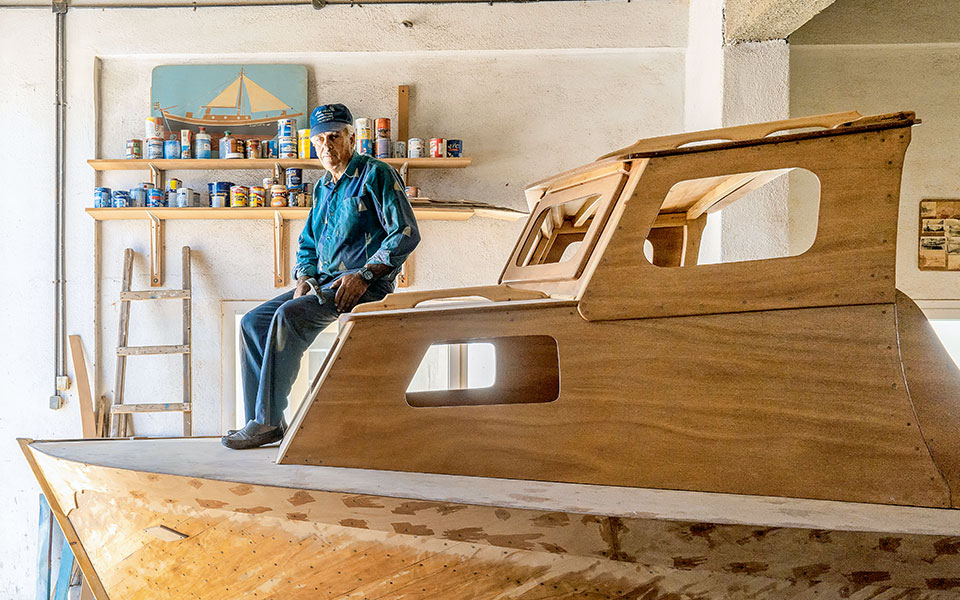
© Perikles Merakos
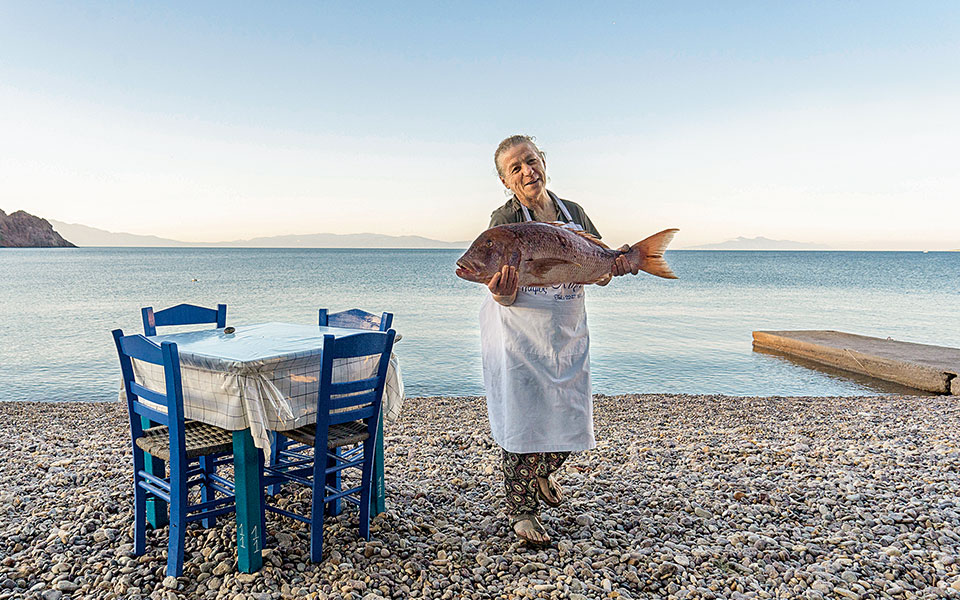
© Perikles Merakos
ART: Patmos attracts and inspires many artists who create fabulous works. Check them out at the galleries in Hora: Kapopoulos Fine Arts (Main Square), Andreas Kalatzis Gallery and Koukoumavla; the last offers a wide variety of particularly tasteful handmade items.
TASTE
LIQUID GOLD: A visit to the agroecological vineyard Domaine Patoinos (Tel. (+30) 694.581.4398) near Vagia is a must. Try their outstanding wine made from the Assyrtiko variety, with its characteristic golden-yellow color, which leaves a delightful aftertaste of fig and sage, and be sure to buy some excellent Koroneiko olive oil.
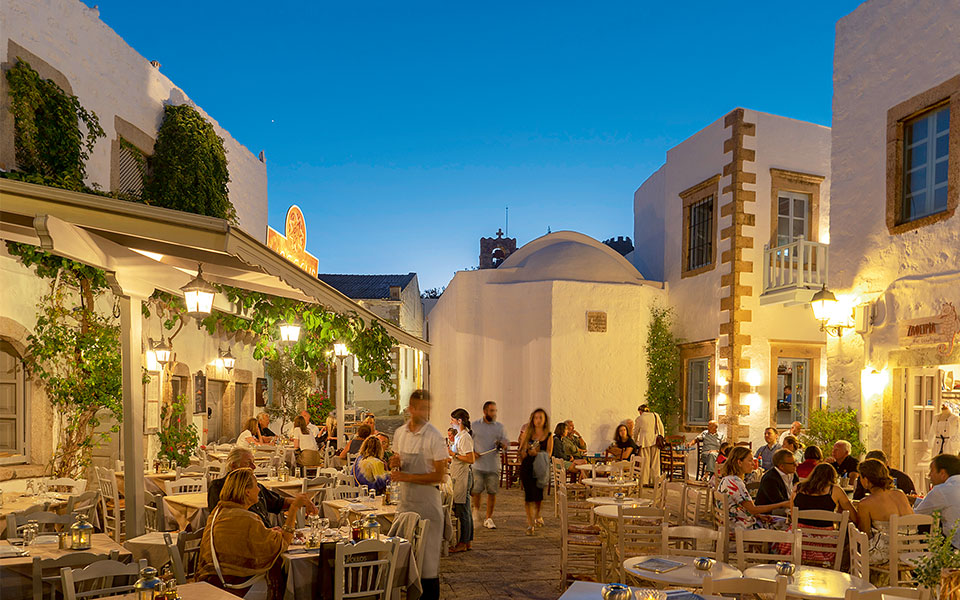
© Perikles Merakos
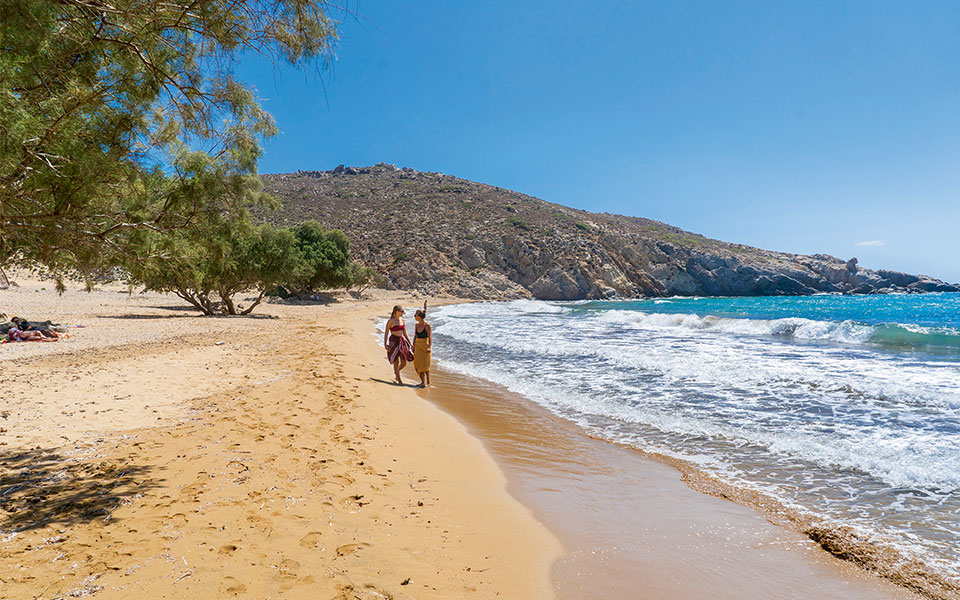
© Perikles Merakos
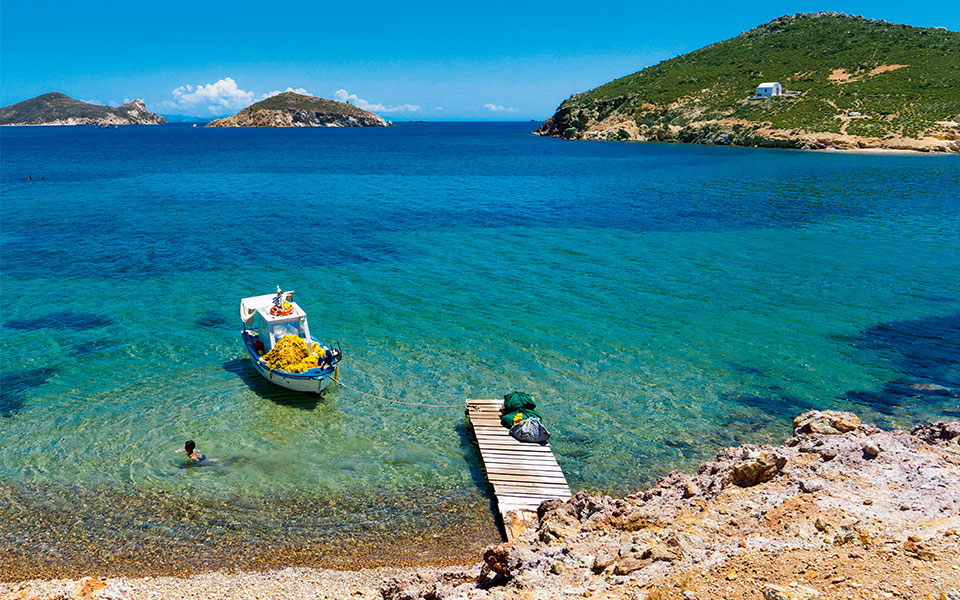
© Perikles Merakos
WHERE TO EAT: At the Pleiades Bar-Restaurant (Sapsila, Tel. (+30) 22470.330.34) celebrated chef Ettore Botrini curates a Mediterranean menu with many culinary highlights, including shrimp risotto with aromatic herbs and vanilla essence, and the calamari with herbs and tarama (fish roe) cream. Open all day, the establishment serves great pancakes for breakfast and also features a plunge pool with a great view. For a romantic dinner by the sea with Grikos Bay and Tragonisi as a backdrop, look no further than Apocalypsis (Patmos Aktis Suites & Spa, Tel (+30) 22470.328.00). Its creative Greek dishes, including cod fritters with cream potatoes and garlic confit purée and Kos pork with bulgur and crunchy chickpeas, will linger long in your memory.
Benetos and Susan Mathaiou opened Benetos Restaurant (Sapsila, Tel. (+30) 22470.330.89) in 1997, offering home-style hospitality and food. They make their own bread and use the finest local ingredients, including freshly caught fish. Their menu has suprises in store, such as grilled salmon with miso (a Japanese soybean paste) or stuffed zucchini blossoms with turmeric sauce. Their wine list includes a number of different Greek selections, and the cocktails that the experienced Jiannis Melianos mixes are amazing. At Trehantiri in Skala (Tel (+30) 22470.340.80), a well-hidden taverna away from the bustle of the busy port town, you’ll find expertly fried small fresh fish, hand-cut French fries, spiny lobster and slipper lobster (by request), along with other fish caught off nearby islands and islets.

© Perikles Merakos
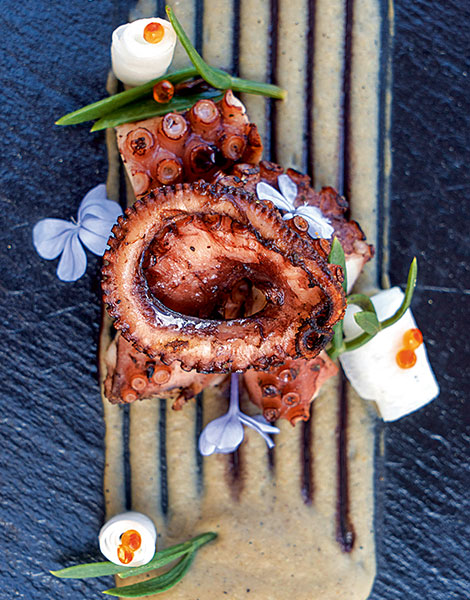
© Perikles Merakos
THE PLACE TO BE: Named after a small bush that grows on Patmos and housed in a charming 17th-century mansion in Hora, Astivi Bar and Restaurant may just be your best option for a night out. Here you can enjoy fine cocktails, accompanied perhaps by pizza or a pasta dish, and spend your entire evening drinking and socializing.
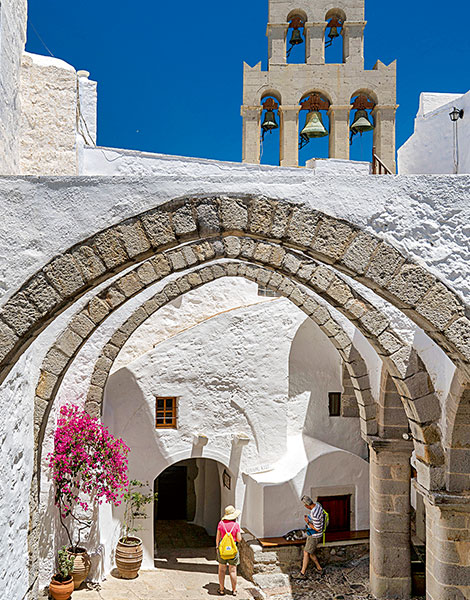
© Perikles Merakos
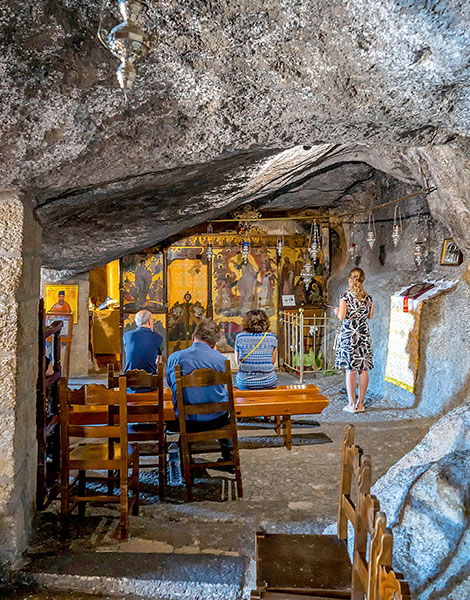
© Perikles Merakos
Focus: “JERUSALEM OF THE AEGEAN”
By John Leonard
Patmos is best known for its significance in Christian history. In antiquity, it was sacred to Artemis who, at the moon goddess Selene’s behest, convinced Zeus to raise the island from the ocean floor. Under Rome’s devoutly pagan emperor Domitian (ruled AD 81-96), Christians, including “John of Patmos,” were widely persecuted. Banished from nearby Ephesus, John – traditionally identified in Greek Orthodoxy as Jesus’ apostle, but distinguished by ancient, medieval and modern scholars as someone distinct from him in writing style and theological approach – came to Patmos (AD 95), settled in a cave, experienced a divine disclosure (“apocalypse”), composed the Book of Revelations and returned to Ephesus (died ca. AD 100). Today, one can still see John’s cave, as well as Byzantine churches and the impressively fortified Monastery of Saint John the Theologian (ca. 1088) which continues to overlook the narrow lanes and charming medieval architecture of Patmos Town.

